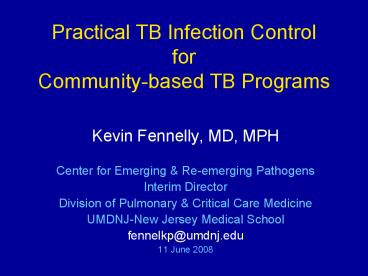Practical TB Infection Control for Community-based TB Programs PowerPoint PPT Presentation
1 / 26
Title: Practical TB Infection Control for Community-based TB Programs
1
Practical TB Infection Controlfor
Community-based TB Programs
- Kevin Fennelly, MD, MPH
- Center for Emerging Re-emerging Pathogens
- Interim Director
- Division of Pulmonary Critical Care Medicine
- UMDNJ-New Jersey Medical School
- fennelkp_at_umdnj.edu
- 11 June 2008
2
Objectives
- To help identify situations in which there is an
increased risk of TB transmission - people (patients) and places (settings)
- To recommend practical solutions
- for programs to help protect staff
- principles and provisions
- for staff
- knowledge is power and prevention !!
3
Areas I will NOT cover
- Abundant evidence that HCWs are at increased risk
for occupational TB infection (and disease) - HCW anyone exposed to patients
- Risk assessment
- Would consider most environments in TB-endemic
countries at high risk
4
from Sol Permutt, 2004
5
TB is transmitted by aerosols (NOT sputum)
6
Particle size suspension in air
- Particle size deposition site
- 100 ?
- 20 ?
- 10 ? upper airway
- 1 - 5 ? alveolar deposition
- Time to fall the height of a room
- 10 sec
- 4 min
- 17 min
- Suspended indefinitely by room air currents
from Sol Permutt, 2004
7
Estimates of Mtb Aerosol Production (quanta per
hour)
- TB ward pt on Rx
- Cavitary TB no Rx
- Laryngeal TB
- Bronchoscopy/ETT
- Autopsy
- 1.25
- 13
- 60
- 250
- 1000
- Fennelly KP. Int J Tuberc Lung Dis
1998 2 S103
8
Who is Infectious?
- Sputum smear gt smear
- AFB 3-4 gt AFB 1-2
- Cavitary gt non-cavitary
- Close gt casual contact
- Prolonged gt brief contact
- Men gt women
- Young gt old
- Borgdorff MW et al. Am J Epidemiol 2001 154934
- HIV HIV
- Cruciani M et al. Clin Infect Dis 2001 331922
- MDR vs. DS ?
9
Where are Patients Most Infectious?
- Congregate settings
- Hospitals
- Correctional facilities
- Bars
- Choirs
- Airplanes, ships
- Indoors gtgt outdoors
- Increased with crowding proximity
- But no data on UV-A or UV-B effects
10
When are Patients Most Infectious?
- Coughing gt Singing gt Talking
- Loudon RG et al. Am Rev Respir Dis 1969100165
- Aerosol producing procedures intubation,
bronchoscopy, sputum induction - Sepkowitz KA. Clin Infect Dis 199623954
- Not on treatment
- Unrecognized/undiagnosed
- Drug-resistant on standard therapy
11
Cough Frequency Infectiousness
Loudon RG Am Rev Respir Dis 1969, 99 109.
12
What is Infectious?
- Dogma 1-5 micron infectious droplet nuclei
(Wells, 1955) - Risk associated with prolonged exposures
- Reality Wells estimated particle size
distribution based on experimental nebulization
of bacillary suspensions in lab - No data from patient-generated aerosols
- Wells calculated droplets less than 25 microns
dessicated to size of infectious droplet nuclei
in less than one second
13
Cough Aerosol Sampling System
- Fennelly KP et al. Am J Resp Crit Care Med
2004 169 604-9
14
Six-stage Andersen cascade impactor
Andersen AA. J Bacteriol 195876471.
15
Cough-generated aerosols of M.tb National Jewish
Medical Research Center
- Fennelly KP et al. Am J Resp Crit Care Med
2004 169 604-9
16
(No Transcript)
17
Cough Aerosol Sampling System
18
Frequency Distribution of Cough-generated
Aerosols of M. tuberculosis and Relation to
Sputum Smear Status
19
Cough-generated Aerosols of M.
tuberculosisNormalized Particle Sizes
Lower limit of size range(µ) 7.0 4.7 3.3
2.1 1.1 0.65 Deposition
Upper airway - bronchi -- alveoli
Abstract, ATS International Conference, 2004.
20
Cough Aerosol ProductionMultivariate Analysis
- Best model in logistic regression
- Bacillary concentration BACTEC lt 4 days to
positive (OR11.35, p0.02) and - strong cough (OR5.41, p0.04)
- Cough strength is associated with performance
score (physical health) (Chi-square, p0.004). - Cough strength tends to be associated with CD4
counts (less advanced HIV infection)
(Chi-square, p0.07). - CD4 counts and performance scores drop out of
multivariate models probably due to correlation
with cough strength. - These data suggest that healthier patients are
more likely to be infectious than very ill
patients.
21
Aerosol CFUs Predict Infectivity in Mice
Abstract, Keystone Symposium on Tuberculosis,
2005.
22
(No Transcript)
23
Wells-Riley Mathematical Model of Airborne
Infection
Assumptions Homogenous distribution of
infectious aerosol over 10 hours uniform
susceptibility.
- Fennelly KP Nardell EA. Infect Control Hosp
Epidemiol 1998 19754
24
Summary PrinciplesTB-IC for Community Programs
- The most infectious TB patients are those who are
not on appropriate therapy - Undiagnosed, i.e., unrecognized
- Drug resistant
- TB is transmitted by aerosols
- Coughing and bacillary load important
- Healthier patients may be more infectious
- Poorly ventilated indoor environments the highest
risk
25
Summary PracticesTB-IC for Community Programs
- Best administrative control
- Suspect and separate until diagnosed
- Surveillance of HCWs with TST (and/or IGRAs) and
rapid treatment of LTBI if conversions occur - Best environmental control Ventilation
- Do as much as possible outdoors
- Use directional airflow when possible
- Natural breeze or fans HCW upwind patient
downwind - Personal respiratory protection
- N95 respirators when indoors or very close
(procedures) - Surgical masks on patients to control source
26
(No Transcript)

